Projectile Motion
Circular Orbits
Elliptical Orbits
Work-Energy Relationship for Satellites
Electricity |
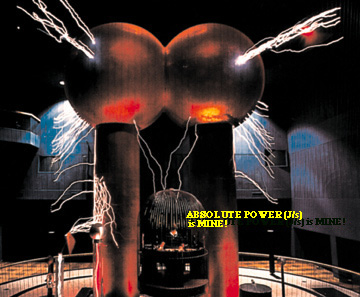 |
![]()
If you balance a broom horizontally on one finger, the center of gravity of the broom will be above your finger - closer to the bristles end than the handle end. If you saw the broom in two pieces at that point, and weigh the two parts on a scale, you'll find that the heavier part is the:
A) bristles part.
B) handle part.
C) both weigh the same.
The planet Jupiter is about 300 times as massive as Earth, yet on its surface you would weigh only about 3 times as much. This is because:
A) your mass is 100 times less on Jupiter.
B) Jupiter is significantly farther from the Sun.
C) Jupiter's radius is 10 times the Earth's radius.
D) Jupiter's radius is 100 times the Earth's radius.
E) you are 100 times more weightless there.
Suppose you roll a ball along a level table so that there is little friction.
- What does the path of the ball look like?
- How far does it travel during 1 second intervals?
- Does it travel further during the second 1-second interval than the first?
Now suppose you drop that ball straight down, off the edge of the table.
- What path does it take?
- How far does it travel during the second 1-second interval compared to the first?
- What is the ball's initial horizontal velocity for this experiment?
Finally, imagine that you roll the ball across the table so that it reaches the edge with some horizontal velocity.
- What path does the ball take from there to the ground?
- How far does it travel horizontally during the second 1-second interval compared the the first interval?
- How far does it travel vertically during the second 1-second interval compared the the first interval?
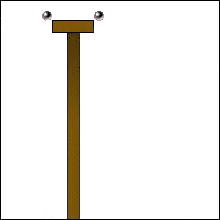
We call this motion (ball rolling of the end of table) projectile motion. It describes the motion of baseballs, cannonballs, divers at the pool, etc.
Timing a throw:
I throw a ball a distance of 40 meters (I wish!) and it leaves my hand travelling horizontally at a distance of 2m above the ground. What was the ball's speed when it left my hand?
At first this seems like a hard problem to figure out. Don't I need to know more, like the time it took for the ball to travel the 40 meters!?
We can determine the time because motion in the vertical and horizontal directions are independent. Vertical motion is governed by gravity, and we can figure that out first. Let's do this.
distance = 1/2 x "g" x t x t
where "g" is our usual suspect and t is time. Since we know the distance the ball falls, we can solve for t:
So the time it takes to fall is 0.64 seconds. What was the ball's (horizontal) speed when it left my hand?
speed = distance / time = 40 m / 0.64 s = 62.5 m/s
A "big-league" pitcher can throw baseballs up to 95 mph. How do I compare?
62.5 m/s x 1 mile/1600m x 3600 s / h = 141 mph !!
OK, so I lied!
Going into orbit:
What if I throw a ball horizontally at 8000 m/s?
Why 8000 m/s?
Well, the Earth is curved after all! It "falls off" about 4.9 m vertically in 8000 m horizontally.
If I throw a ball at 8000 m/s, it travels 8000 meters in the second it takes it to fall 4.9 m (that's half of that 9.8 thing). After a second the ball is at the same distance away from the Earth as when it started.
I can put that ball into orbit! Time to start training.
What happens if we launch our ball at greater than 8000 m/s? The path the ball would travel would not be tangential to the Earth. Thus Earth's gravity would work to slow it down. It would eventually curve around and start back towards the Earth, speeding up as it goes. The path would form an ellipse.
You may have been told that the Earth's and other planet's orbits around the Sun form ellipses. What are ellipses? What does that mean in terms of their orbital motions?
Ellipses are like circles, only they have two focii instead of one center. In analyzing Tycho Brahe's careful observations, Johannes Kepler recognized that the Sun sits at one of the focii of every planet's orbit.
Aside: how elliptical is the Earth's orbit? Answer: Not very! The ratio of the distance between the two focii to the major axis (the eccentricity) is .017. It is difficult to draw this orbit without it looking like a circle.
Here is a cool site summarizing how projectiles can be launched to become satellites.
What is the energy situation of a satellite in orbit?
Circular orbit:
- Does its kinetic energy (KE) change as it orbits? Why or why not?
- Does its gravitational potential energy (GPE) change as it orbits? Why or why not?
- What about its total energy?
Elliptical orbit:
- Does its kinetic energy (KE) change as it orbits? Why or why not?
- Does its gravitational potential energy (GPE) change as it orbits? Why or why not?
- What about its total energy?
- What does the force look like on a satellite in an elliptical orbit?
![]()
Through various means we know that matter is comprised of atoms, and that atoms consist of protons, electrons and neutrons.
Charge is a property of electrons and protons, and serves to hold together atoms. Negatively-charged electrons can be mobile because they have 1/1830 of the mass of the positive proton. Neutrons have the same mass as a proton, but no charge. Also, protons and neutrons are found in the nuclei of atoms, and are held there by a different type of force.
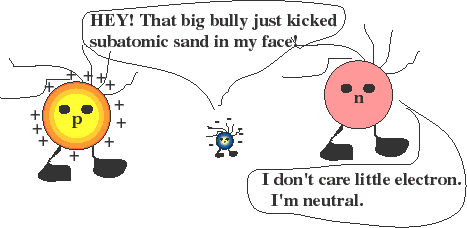
Protons are the original homebodies. They are NOT easily removed from a nucleus and do NOT constitute the positive charges that we see in physics class.
Instead, "holes" are the name physicists give to missing electrons. They are mobile like electrons and have effective positive charge.

Charge comes in bundles of specific size, as the proton's charge is the same as the electron's (but with opposite sign). The size of this bundle is called a quantum of charge. Charge comes in bundles that are indivisible.... one can have a charge of +1, +2, +3, etc, but not of 1/2 or 1/3. Charge is measured in Coulombs (C).
An object with -1 coulombs of charge has a net surplus of 6 x 1018 electrons! Clearly it is possible to separate many, many electrons from their "home atoms" and, thus create charged materials.
![]()
1) Forces between like charges: Take two pieces of scotch tape. Stick them to a table along most of their length. Rub them down so they adhere strongly to the table. Rip each piece off the table. You have just charged each piece in the same way with the same type of charge. Holding them by their ends, bring them near each other. What happens? Why?
2) Forces between unlike charges: Charge a metal coated pith ball by rubbing a black rubber rod on cat fur. That makes the rod negative (excess electrons, remember its very negative to rub a kitty this much). Touching it to the pith ball allows some of the charges to escape to the pith ball. (Why?) Now charge a lucite (clear) rod by rubbing it on silk and hold it near the negatively-charged pith ball. What happens? The lucite rod is charged positively. What "rule" can you make after observing this phenomenon?
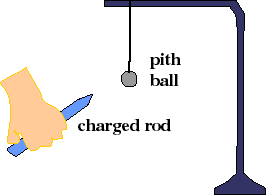
3) Forces between unlike charges: Take two different pieces of tape. Stick one to the table, then stick the other on the back of the first piece. Again, rub them so that they adhere well. Rip off the top piece of tape. Similar to before, its now charged. Where are the opposite, remaining charges? Rip off the second piece and hold the two pieces close together. What happens?
4) Polarization: Again charge the black rod negatively. Bring it near an uncharged pith ball. What happens first? What happens after the ball and rod touch? Can you describe the charge distribution on the pith ball before they touch? If so, why is the ball attracted to the rod?
5) Charging by induction: Use electrophorous plates as follows: Rub animal fur on the black (bakelite) surface of the device (its base). What is the net charge of this surface after doing so? Place the aluminum disk on the base. What happens to charges on the disk? Touch the aluminum disk. What happens next? What charge is left on the disk. Use the charged disk to light a gas discharge tube.
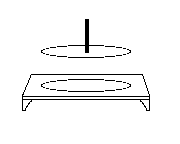
6) Charge polarization in water: Comb your hair with a black plastic comb. What is the charge on the comb afterwards? Place the charged comb near but not touching a small stream of water. What happens? Why?
7) Conservation of charge: Charge isn't 'manufactured.' In order to observe and exploit the properties of charge, we separate unlike charges. A good example of a 'charge separator' is a battery. Conservation of charge says that, since we typically separate charge, the numbers of positive and negative charges are the same.
Summary: The results of these simple experiments reinforce the ideas that like charges repel, unlike charges attract, and that the electric force between charge diminishes with distance.
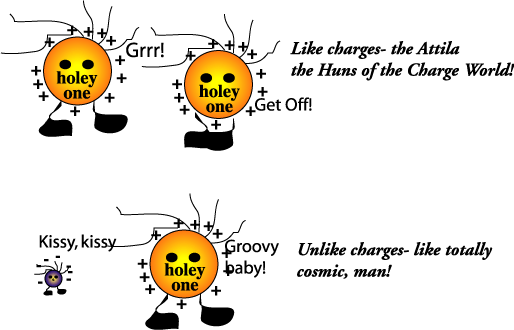
In saying that the charged rods/pith balls repel or attract, we really mean that they exert forces on one another.
The negative charge on the metal surface of the pith ball is attracted to the positively-charged glass rod. It moves as close as it can get to it, bringing the pith ball with it. The oppositely charged pieces of tape are observed to move towards each other because of forces on their charges.
Try this experiment with the charged tape (either like or unlike charges). Hold them close enough together so that they just begin to deflect (either away from or towards one another). Now move them closer together. What happens? Why?
(Did the amount of excess charge on the tape change when you did this?)
Coulombs' Law
In this case, "q" is the standard symbol that means "amount of charge (in Coulombs, "C").
The separation is typically stated in meters (m). The constant for these units is:
checkpoint: For two objects with given charges q1 and q2, the force between them will diminish by 1/4 if the separation between the objects is increased by 2.
It turns out that this is exactly analogous to the force between two masses, which we have termed "the force of gravity." For gravity, however, we always are referring to the attraction of an object to the Earth. As the Earth is really quite large, moving small distances above its surface has very little effect on the force (and acceleration) of gravity.
checkpoint: So how are gravity and electrical forces different?
To observe the electric force in action, we can watch what happens when styrofoam balls sitting on top of a Van de Graff generator accumulate excess charge from the generator:
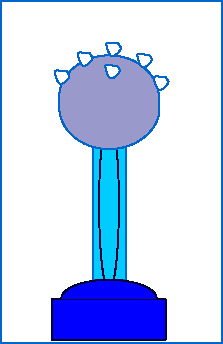
The shiny dome on top of the Van de Graaf generator appears to be made of a special substance. What is it? Why do you suppose it is made out of that?
Charge (electrons in this case) can move easily between metal atoms that are arranged in an orderly lattice. We call this type of material a conductor. Wires are conductors and are usually made of metal.
What about the sticky tape? Is it a good conductor of charge? How could you tell?
Consider two objects, each with an excess of the same type of charge. These two objects will tend to repel each other.
Our rule (tested hypothesis), above, says these two will tend to repel each other. In fact they will repel each other more (with greater force) if the charges are moved closer together. (Another prediction of Coulomb's Law, above, is that increasing the amount of charge-- q --will result in a greater force.)
Imagine pushing one of the "charged" objects towards the other, which is fixed and can not move.
That increase is called electric potential energy. If you let go of the moved object it will want to fly away from the fixed, charged object, converting electric potential energy into kinetic energy.
For two different positions for the moved object-- one close and one further from the fixed, charged object, there would be a difference in electric potential energy.
Voltage depends upon this difference.
Voltage always refers to two separate locations. For example, a "D-cell" nominally provides 1.5 volts between its positive and negative terminals. It doesn't make any sense to refer to the voltage at a single location.
We further define voltage as a difference in potential energies divided by charge:
Our battery voltage source rating tells us how much work it can do on one unit of charge. Think of voltage as the "charge push or pull" that causes charges to accelerate from one side of the voltage source towards the other, usually through a circuit made of wires and other things.
A more technical description says that "a volt is the potential difference necessary to change the energy of 1C (coulomb) of charge by 1J (joule) in moving the charge between two points." (source of quotation: Energy, by G Aubrecht, 1995, Prentice-Hall)
![]()